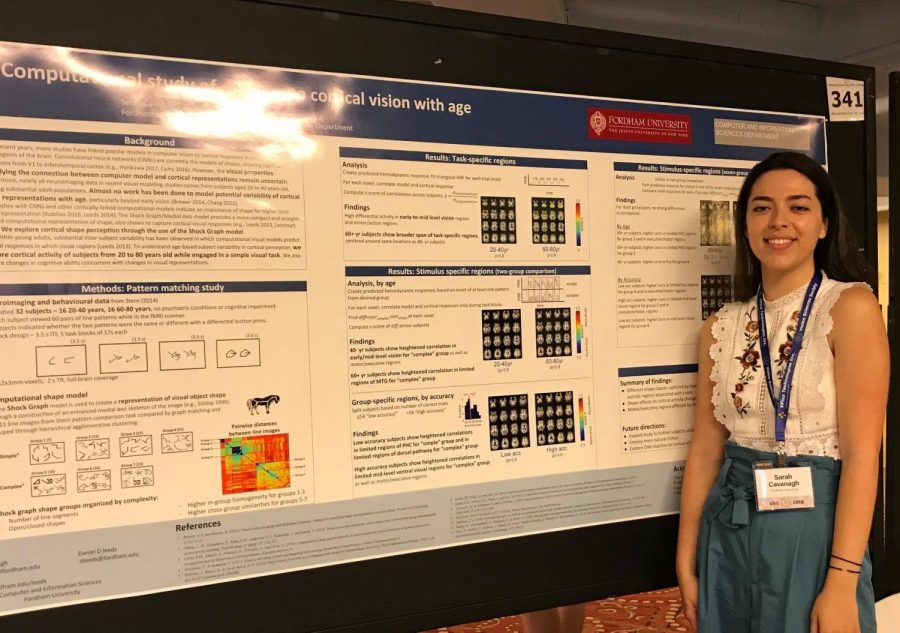Student Studies How The Brain Changes With Age
By Julia Rist
Sarah Cavanagh, FCRH ’19, majors in integrative neuroscience with a systems and computation concentration. Cavanagh, who also minors in mathematics, studies how the brain changes as people age.
Cavanagh said there is no shortage of research opportunities at Fordham. She began her project, a computational study of changes to cortical vision with age, in May 2017. In addition to her own research, she also works as a research assistant for two community based oral history projects: the Bronx African American History Project (BAAHP) and the Bronx Italian American History Initiative (BIAHI).
Cavanagh said she found out about research in an English class.
“I found out about the BAAHP through my Texts and Contexts class, and I loved the idea of becoming more involved in the Bronx,” she said. “The BIAHI was created the semester after I started working with the BAAHP, and I also wanted to be involved with that.”
The Bronx African American Project is a partnership between Fordham University and the Bronx County Historical Society to help uncover the history of the Bronx through audio interviews.
According to its website, the BAAHP’s main purpose is to preserve the history of the borough.
“We hope our work will be of use to scholars, students, teachers, public historians and museum curators who are doing research on people of African descent in New York City or general scholarship on the social development of 20th century American cities,” said the website. “We continue to identify, preserve, catalog, and make accessible archival record collections relating to the history of people of African descent in the Bronx.”
Cavanagh works alongside Mark Naison, Ph.D., a professor of history and African American studies at the Fordham College at Rose Hill, to record and archive these interviews.
Cavanagh is also a part of the Bronx Italian American History Initiative, which studies the history of Italian Americans in the Bronx.
She said one of the best part about being involved in research at Fordham is having the opportunity to present one’s work all over the country.
“One of my favorite moments was being able to travel to Florida last May to the Vision Sciences Society’s annual meeting and present my work at the conference,” said Cavanagh. “It was incredibly rewarding to have professionals in the field I want to enter be interested in my work.”
For Cavanagh’s neuroscience project, Daniel Leeds, Ph.D., an assistant professor in the Department of Computer and Information Sciences, serves as her research mentor and advisor.
Cavanagh decided to pursue a research project about vision and aging because of its relevance in the field of neuroscience.
“Vision in the brain is subject to rigorous ongoing study. and computational models of cortical vision have become a major area of focus in recent years,” she said. “Secondly, I plan to eventually pursue doctoral work in computational neuroscience, and working on this project has been great preparation for long-term research.”
Cavanagh said that Leeds and her adapted neuroimaging and behavioral data for almost 300 subjects. These participants ranged in age from 20 to 80 years old. This data was collected and adapted from Stern’s 2014 “The Reference Ability Neural Network Study” at Columbia University.
Cavanagh said her results of the study showed that a healthy brain does in fact change with age, but the degree of the change depends on the individual.
“I found that different classes defined by the Shock Graph computational model have differential effects on cortical activity inside vision associated regions,” she explained. “I found that these effects do change with age. The fact that the brain activity changes with age gives us insight into how different age groups represent shape.”
Cavanagh said that when she first started conducting her research, there was a steep learning curve that she had to overcome.
“I had to learn a new programming language and was suddenly exposed to advanced topics in computational neuroscience that were completely new to me,” Cavanagh said. “But Dr. Leeds has always been great about setting aside time to help me and make sure I understand the reasoning behind everything I’m doing,”
Cavanagh is planning on publishing her work, and she is currently working on compiling a formal paper to submit to peer-reviewed journals like Psychology and Aging.












































































































































































































